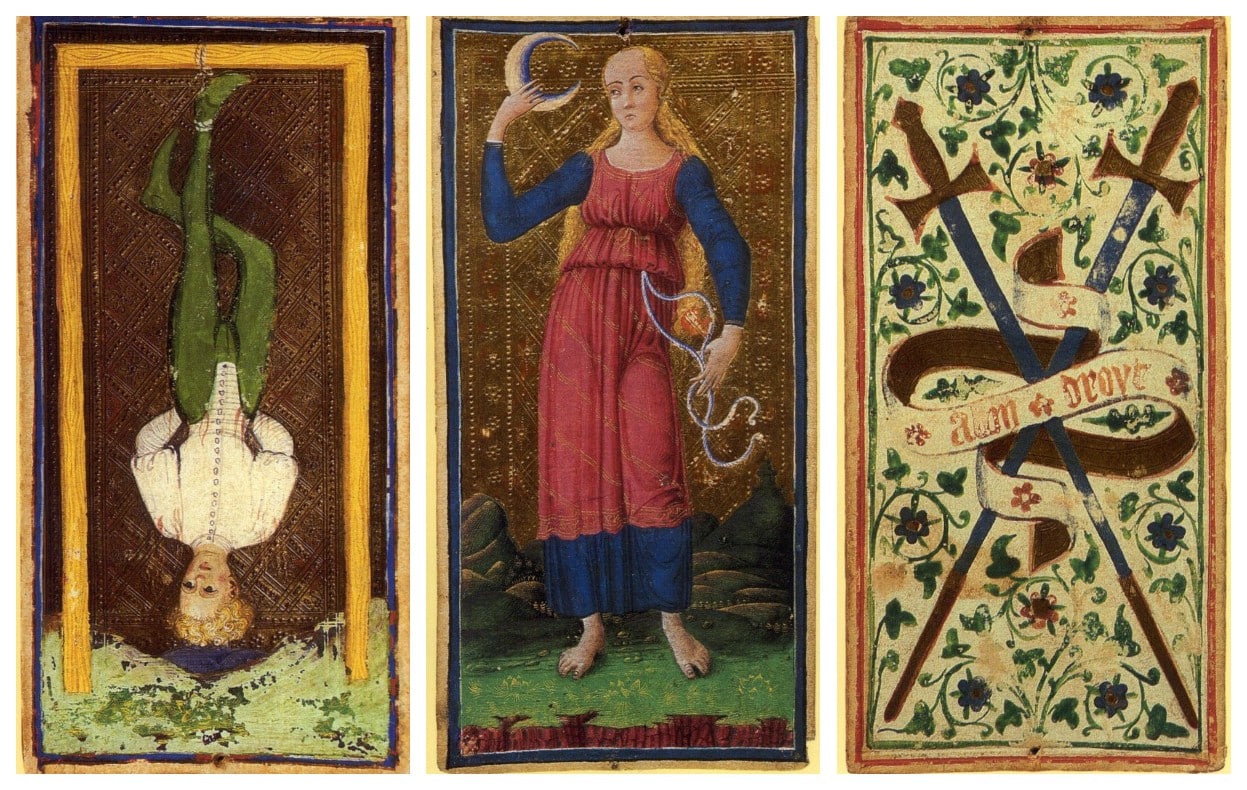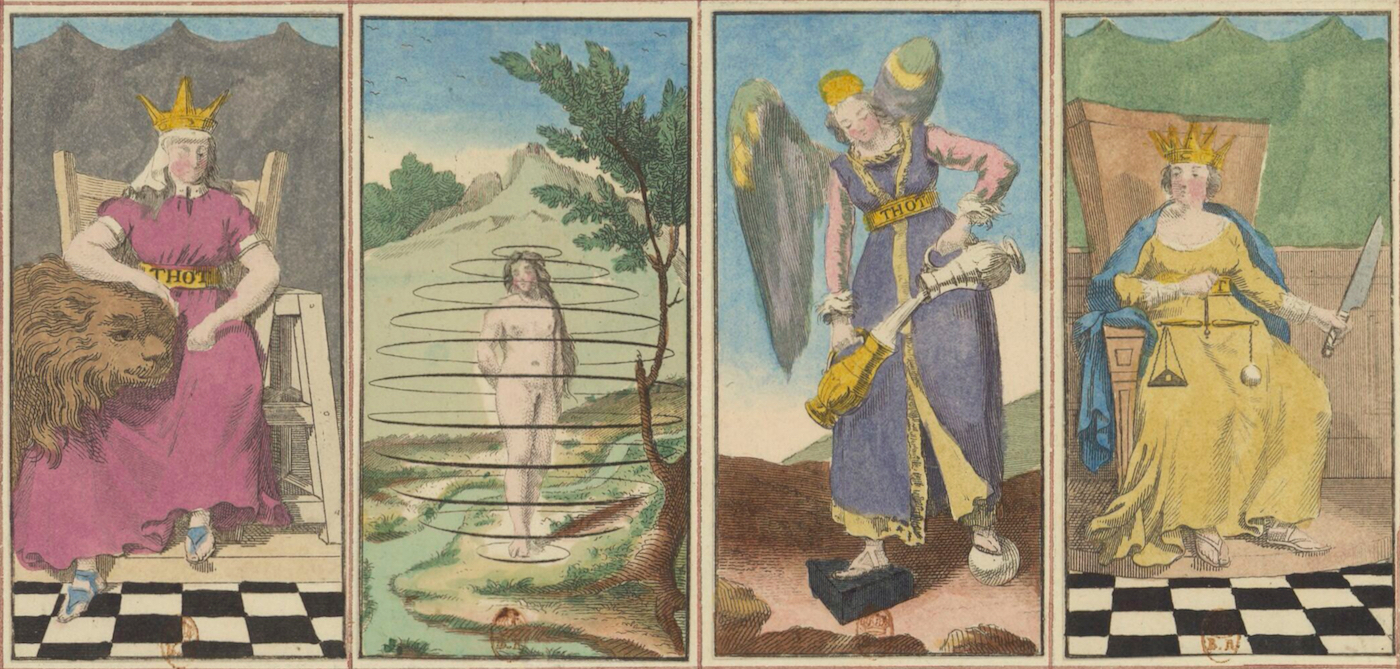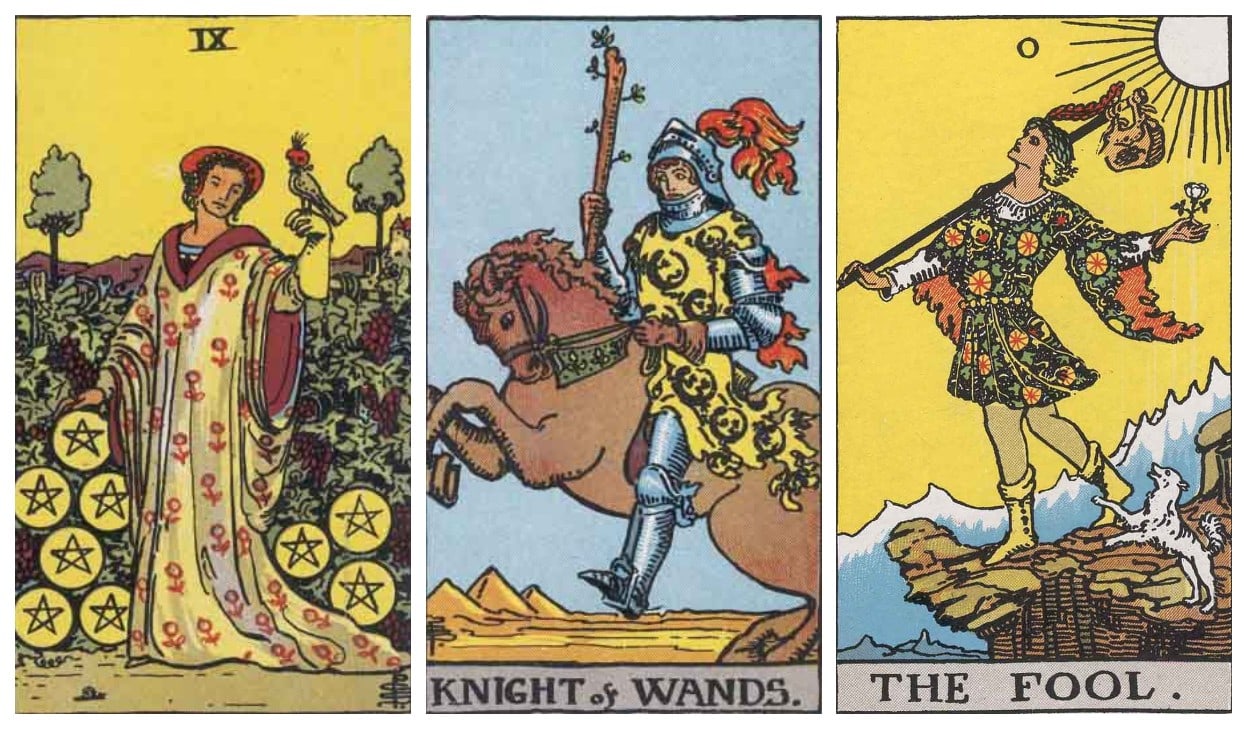6.9 KiB
| title | author |
|---|---|
| History of Tarot | Ada |
:::::{#historyoftarot .has-images}
An hypothesised and randomly factual History of Tarot Cards
What follows is the story of a deck of cards and of all the more-or-less believable claims that were made about its origin. This brief history was complied following sources that attempted accurate historic recalling instead of the most commonly shared semiotic, occultist story. However, despite all efforts all the found sources told a convoluted story due to the misinterpretation of age, sources and authorship common in any ancient text on magic and mysticism (Dummett, 1993). As such, the following text will recall the disproven stories that were told about the origin of Tarot, some factual sourced material and a modern description of its usage.
When we talk about Tarot cards we are talking about a deck of playing cards composed of ten numeral cards and four court cards(Jack, Knight, Queen and King) for each of the suits, Swords, Batons, Cups and Coins. Alongside these more common cards Tarot includes 22 'trump' cards with allegorical illustrations. The trumps form a sequence, usually numbered from 1 to 21, with the single card of the Fool being separated (Decker, Depaulis & Dummett, 1996).
This specific deck of cards' history begins at the bottom of a well in Norther Italy, in the 1440s, where we place its first appearance in history. From there we can easily find links to the common usage of these cards in Norther Italy, from Milano to Bologna e Ferrara (Steele, 1900). These cards, initially called Trionfi and then Tarocchi are thought to have been intended to be used for card games, regardless of their occasional usage in future-telling (Dummet, 1993). This finding helps us trace a factual beginning of Tarot but leaves an open question to how these cards gained their place as the primary tool used in modern occultism and mysticism for cartomancy.
While this is where the story began to intricate itself, it can still be seen that the first wide spread future-telling uses appeared in France in the 18th century.
At this point the history of tarot beings to be influenced by what each fortune teller imagined the history of the cards to be. To fully disclose this I will first attempt to estimate the most notable occultists that used the cards and wrote historical notations about their deviance and then the stories they told about them.
The first encounter we have between Tarot and magical theory and practice happens in the Monde primitif, an incredibly long essay about Tarot cards written in 1781 by Antoine Court de Gébelin. With this text, the pastor began what would be the endless repository of arcane esoteric wisdom within Tarot that will follow the cards for generations (Chisholm, 1911). In this text, Gébeling attributed the cards' origin to ancient Egypt, a theory that is to this day shared as truthful. This belief was based on an erroneous link to "The Book of Thoth", an ancient Egyptian text about magic that is believed to have been spread through Europe by Romani people. This belief was then substantiated by a similar essay by the by the comte de Mellet(Decker, ). Promptly, a Parisian fortune teller named Jean-Baptiste Alliette, professionally known as Etteilla, having found these theories, adapted the esoteric view of the cards to his own uses. He switching his own practice from traditional French piquet cartomancy to the use of a self-made Tarot card deck. This deck was based on the previously shared Hermetic ideologies and was named "The Book of Toth"(same).
The next fundamental spin that was given to the cards' background was down by Éliphas Levi, another French esotericist. Levi repudiated Etteilla's theory and integrated a version of the cards that was closer to the original to his own Cabalistic magical system. However historically mistaken was Levi's understanding of the cards' travel from Egypt to Judea into Jewish tradition, it nonetheless revolutionised the cards in ways that live on till today. His Cabalistic theory about signs being letter, letters being absolute ideas and absolute ideas being numbers can be seen in even modern iterations of tarot.
From here on over, Tarot's journey speeds up as the cards leave France and become absorbed into new esoteric movements like Swedenborgianism, Mesmerism and spiritualism (Decker, Depaulis & Dummet, 1996).
Before we make a jump through time to the next biggest relevant development of Tarot, I will share the last of the three false widespread theories about the origin of Tarot, the first two being Egypt and Judaism(despite its influence in modern tarot).
This last theory is harder to trace back to one esoteric influence, but nonetheless claims a Chinese origin to the cards. Most likely, this is due to the similarity with the I Ching, a divination manual from around 1000 BC. The manual was grounded in cleromancy, the production of random numbers to predict divine intention. However, there is no traceable connection between Chinese cleromancy and Tarot divination. Modern analyses of Chinese Tarot divination draw direct correlation between Western occultism and Tarot divination, leaving little room to imagine any direct causation starting from China (Fu, Li, Lee, 2002).
For the purpose of this recalling but unsurprisingly for those familiar, the next big step will bring us to the late19th century in Britain, in the Hermetic Order of the Golden Dawn. The Golden Dawn was a secret society devoted to occult Hermetic Kabbalah and one of the largest single influences on Western occultism as a whole (Jenkins, 2000). While the society itself had a wide curriculum, including astrology, alchemy and geomancy(soil divination), our only concern at the moment is with their links to Tarot cards.
In 1909, two mystics and members of the Golden Dawn, A.E. Waite and Pamela Colman Smith published with the Rider Company a deck of re-made Tarot cards based on the society's magic system. These cards, later known as the Ride-Waite Tarot(Dean, 2015). This deck was based on the Sola Busca deck, with symbolism being taken from Levi's descriptions and Egyptian and Christian symbolism. This deck has become the paradigm and touchstone through which modern occultists think of Tarot. Between the distribution of this deck and the use of the cards in the Golden Dawn, it became axiomatic among followers many traditions of mysticism that the Tarot is an essential component of any occult science.
Nowadays, Tarot is emblematic and incredibly wide spread as the most common future-telling method and device. Thousands and thousands of different formats exist, often falling under the category of Oracle cards and as such not having the clear formatting rules of Tarot but still implicating divination and self-reflection through the interpretation of allegorical illustration.


